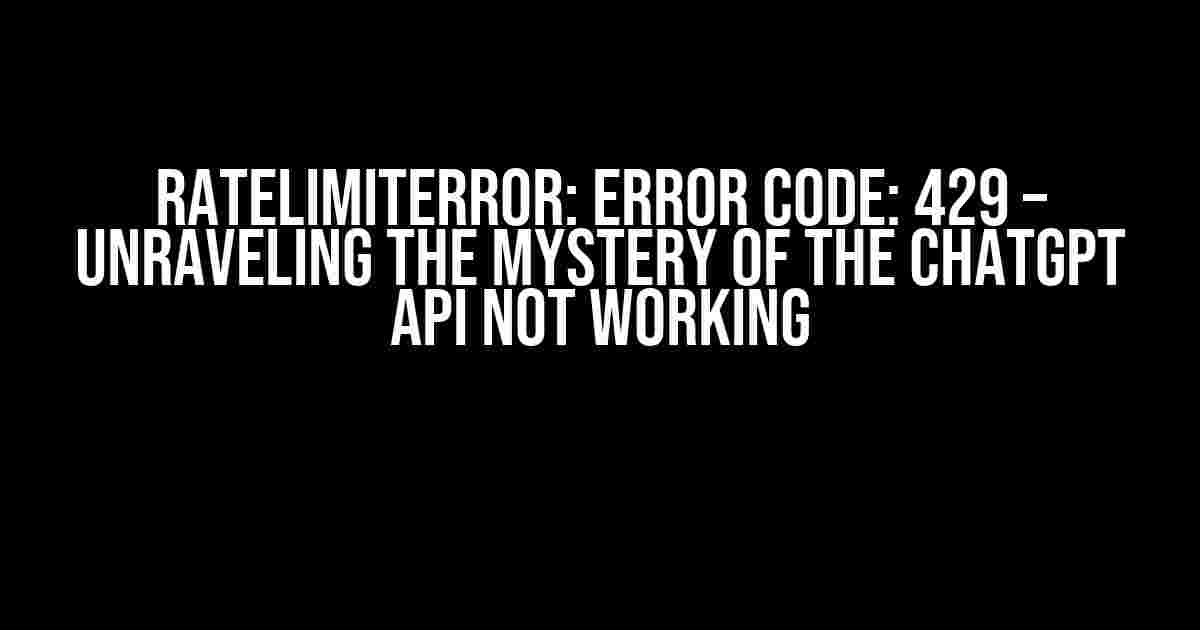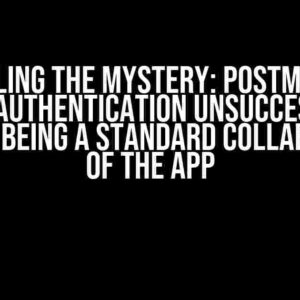Are you tired of encountering the frustrating RateLimitError: Error code: 429 when trying to access the ChatGPT API? You’re not alone! This error has been plaguing developers and users alike, leaving them scratching their heads in desperation. But fear not, dear reader, for this article is here to guide you through the troubleshooting process and provide you with actionable solutions to get the ChatGPT API up and running smoothly.
What is a RateLimitError?
A RateLimitError is an error response returned by the ChatGPT API when your application exceeds the predetermined rate limits set by the API developers. This error is triggered when your application makes too many requests within a short span of time, causing the API to temporarily block your access.
Why Does the ChatGPT API Have Rate Limits?
The ChatGPT API has rate limits in place to prevent abuse, ensurefair usage, and maintain the performance of the API. Rate limits help prevent malicious activities such as spamming, scraping, or denial-of-service (DoS) attacks, which can compromise the integrity of the API and affect its overall performance.
Causes of RateLimitError: Error code: 429
Before we dive into the solutions, let’s explore the common causes of the RateLimitError: Error code: 429:
- Excessive requests from a single IP address or user agent
- High traffic volume from a single application or service
- Malicious activities such as spamming or scraping
- Incorrect API key or authentication credentials
- API endpoint abuse or exploitation
Troubleshooting Steps for RateLimitError: Error code: 429
Now that we’ve covered the causes, let’s move on to the troubleshooting steps to resolve the RateLimitError: Error code: 429:
Step 1: Check Your API Key and Authentication Credentials
Verify that your API key and authentication credentials are correct and up-to-date. Make sure you’re using the correct API key format and that your credentials haven’t expired.
api_key = "YOUR_API_KEY"
headers = {
"Authorization": "Bearer " + api_key,
"Content-Type": "application/json"
}Step 2: Verify Your Request Rate
Check your request rate and ensure it’s within the allowed limits. You can use tools like curl or Postman to monitor your request rate and identify any potential issues.
curl -X GET \
https://api.chatgpt.com/v1/conversations \
-H 'Authorization: Bearer YOUR_API_KEY' \
-H 'Content-Type: application/json'Step 3: Implement Exponential Backoff
Implement exponential backoff to reduce the request rate and prevent further error responses. Exponential backoff involves increasing the delay between requests by a power of 2 (e.g., 1s, 2s, 4s, 8s, etc.)
import time
import random
def exponential_backoff(retries=5, delay=1):
for i in range(retries):
try:
# Make API request here
pass
except RateLimitError:
delay *= 2
time.sleep(delay + random.uniform(0, 1))
continue
breakStep 4: Use a Proxy or Cache
Consider using a proxy or cache to reduce the number of requests made to the API. This can help distribute the load and prevent rate limiting.
import requests
proxy_url = "http://your-proxy.com:8080"
cache_timeout = 300 # 5 minutes
def make_request(url):
try:
response = requests.get(url, proxies={"http": proxy_url, "https": proxy_url})
# Cache response for 5 minutes
cache.set(url, response.json(), timeout=cache_timeout)
except RateLimitError:
time.sleep(60) # Wait for 1 minute before retrying
make_request(url)Step 5: Contact ChatGPT Support
If none of the above steps resolve the issue, it’s time to reach out to ChatGPT support for assistance. They can help you diagnose the problem and provide guidance on how to resolve it.
Best Practices to Avoid RateLimitError: Error code: 429
To avoid encountering the RateLimitError: Error code: 429 in the future, follow these best practices:
- Monitor your request rate and adjust accordingly
- Use efficient data retrieval techniques (e.g., batching, caching)
- Implement exponential backoff for retrying failed requests
- Use a proxy or cache to reduce the number of requests
- Test your application thoroughly to identify potential issues
Conclusion
The RateLimitError: Error code: 429 can be a frustrating obstacle, but with the right troubleshooting steps and best practices, you can overcome it and get the ChatGPT API working smoothly. Remember to monitor your request rate, implement exponential backoff, and use a proxy or cache to reduce the load on the API. If all else fails, don’t hesitate to contact ChatGPT support for assistance.
| Rate Limit Error Code | Description |
|---|---|
| 429 | Rate Limit Exceeded |
| 401 | Unauthorized Access |
| 503 | Service Unavailable |
By following the guidelines outlined in this article, you’ll be well-equipped to handle the RateLimitError: Error code: 429 and ensure seamless integration with the ChatGPT API.
FAQs
Q: What is the rate limit for the ChatGPT API?
A: The rate limit varies depending on the API endpoint and your subscription plan. Check the official ChatGPT API documentation for more information.
Q: How can I increase my rate limit?
A: You can increase your rate limit by upgrading your subscription plan or by contacting ChatGPT support for a custom solution.
Q: What is the difference between a rate limit and a quota?
A: A rate limit refers to the number of requests allowed within a specific time window, whereas a quota refers to the total number of requests allowed within a certain period (e.g., daily, monthly).
Frequently Asked Question
Are you stuck with the dreaded “RateLimitError: Error code: 429” and your ChatGPT API is not working? Don’t worry, we’ve got you covered! Check out these frequently asked questions to get back on track.
What is a RateLimitError, and why am I getting it?
A RateLimitError occurs when you exceed the maximum number of requests allowed within a certain time frame, usually per minute or per hour, as set by the API provider. This error code 429 indicates that you’ve reached the rate limit, and the API is temporarily blocking your requests to prevent abuse and maintain system performance. It’s not you, it’s the API’s way of saying, “Hey, slow down!”
How can I avoid hitting the rate limit in the future?
To avoid hitting the rate limit, you can implement a few strategies: 1) space out your requests over time, 2) use batch requests when possible, 3) use caching to reduce the number of requests, and 4) consider upgrading to a paid plan with higher rate limits. It’s all about being a responsible API user and respecting the limits set by the provider.
What can I do to resolve the RateLimitError: Error code 429 right now?
To resolve the error, you can simply wait for a short period (usually 1-5 minutes) to allow the rate limit to reset. You can also try retrying your request with an exponential backoff strategy to give the API some breathing room. If you’re using an API library or wrapper, check if it has built-in support for handling rate limit errors.
Is there a way to check the remaining rate limit before making a request?
Yes, many APIs, including ChatGPT, provide headers or response fields that indicate the remaining rate limit. Look for headers like `X-RateLimit-Remaining` or `X-RateLimit-Reset` to check the remaining limits before making your next request. This way, you can plan ahead and avoid hitting the rate limit.
What if I need to make a large number of requests for my application?
If you have a genuine use case that requires a high volume of requests, consider reaching out to the API provider to discuss possible solutions. They might offer paid plans with higher rate limits, custom rate limits for your specific use case, or even dedicated support for high-volume users. Don’t be afraid to ask – they might be willing to work with you to find a solution.




